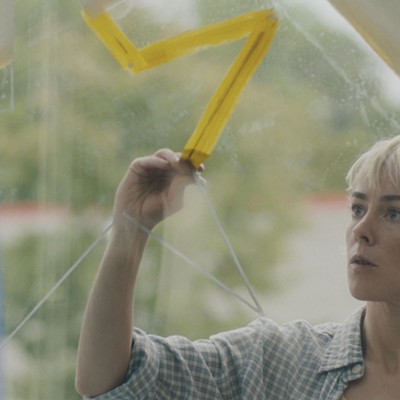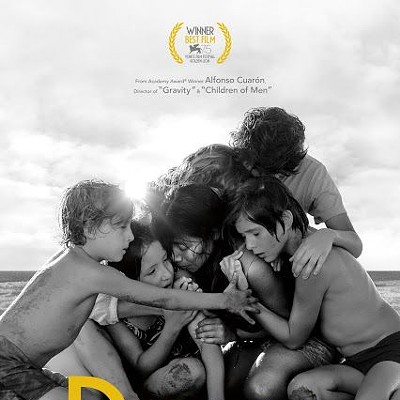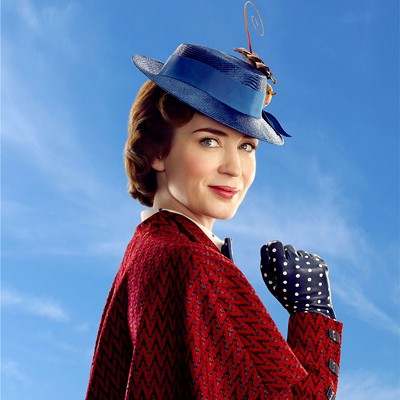Hellboy ii: The Golden Army
Among the more disappointing of these countless comic book adaptations that, if nothing else, have given purpose to the lives of fanboys across the country (that purpose, of course, being to bash anyone who doesn’t completely share their views). That Hellboy II fails to deliver the goods is a real shame: While most of writer-director Guillermo del Toro’s earlier titles have been noteworthy (including The Devil’s Backbone and the underrated Mimic), his Oscar-winning Pan’s Labyrinth suggested that he had firmly entrenched himself in the ranks of the top-tier filmmakers working today (not at the level of Spielberg or Scorsese, of course, but certainly equal to Peter Jackson). Yet while this sequel to the 2004 feature (itself based on Mike Mignola’s comic series) doesn’t lack for visual wonders, it’s utterly clumsy in the storytelling department, a genuine shock given del Toro’s usual ability to spin a tall tale. Here, Hellboy (Ron Perlman), the satanic emissary who fights on the side of right, must face off against Prince Nuada (Luke Goss), an albinotic, ancient leader who hopes to revive the Golden Army to destroy humankind. The lumbering brutes who comprise the army are pretty cool, though they’re overshadowed by del Toro’s other monstrous creations, including a gigantic plant-man who crashes through the New York streets like a “Go Green” Godzilla and Tinkerbell-sized fairies whose collective appetite suggests nothing so much as a school of barracudas.
JOURNEY TO THE CENTER OF THE EARTH
Ever since the 3D process first appeared in cinema in 1952’s Bwana Devil (advertised with the tagline, “A lion in your lap! A lover in your arms!”), filmmakers have attempted to turn this innovative technique into more than just a fad that appears at regular intervals over the years. 1953’s Vincent Price chiller House of Wax arguably remains the most famous of all three-dimensional efforts (further containing the most iconic of all 3D images, that of the street barker bopping his paddleball right into moviegoers’ faces), though I imagine the 1969 softcore smash The Stewardesses 3D also has its ardent supporters. But poorly produced movies like Jaws 3-D and Friday the 13th Part III did little to advance the cause -- donning the requisite spectacles only resulted in muddy colors bleeding on the screen -- and it wasn’t until last year’s Beowulf that the technology was finally perfected. Seeking to build upon Beowulf’s breakthrough, Journey to the Center of the Earth takes the 3-D ball and runs with it. In presenting this tale of a scientist (Brendan Fraser) who discovers that Jules Verne’s classic novel is more fact than fiction and subsequently travels beneath the surface with his surly nephew (Josh Hutcherson) and their hottie guide (Anita Briem) in tow, the filmmakers throw everything but a three-dimensional kitchen sink at us: a dinosaur’s snapping jaws, prehistoric piranhas’ pointy teeth, oversized Venus flytraps, bouncing balls, a protruding tape measure, even spittle. It’s all rather nifty, but the problem is that the majority of movie theaters are not showing the picture in 3-D (most multiplexes don’t have the capability yet). And whereas House of Wax and Beowulf remain entertaining yarns when watched in the normal, flat format, this Journey is so insipid that it’d be a chore trying to sit through the simple-minded narrative without the added incentive.
MEET DAVE
How many times have we moaned about how “all the best parts were shown in the trailer”? Meet Dave takes the opposite stance: Based on the preview, this vehicle for Eddie Murphy looked as if it would compete with The Love Guru in the sheer awfulness department. And make no mistake: What’s presented is still pretty bad. But compared to Mike Myers’ toxic effort, this almost comes off as Annie Hall by comparison. What the trailer doesn’t convey is that Murphy actually delivers a sharp comic performance as Dave, a human-shaped-and-sized spaceship powered by the tiny aliens within. He also plays the diminutive captain of the spacecraft, but he isn’t especially memorable in this dry role, spending much of the time alternately wooing a fellow shipmate (Gabrielle Union) and a friendly Earthwoman (Elizabeth Banks, who earlier this year co-starred in the similarly titled Meet Bill), as well as slowly learning that our planet and its inhabitants are capable of offering compassion and beauty and great movies like It’s a Wonderful Life. It’s Murphy’s work as the walking, talking spaceship that’s inspired, as the character amusingly reacts to the surplus of confusing information flooding his system (as when Banks’ Gina announces that they’re eating meatloaf for dinner and the ship’s computer brings up images of the burly rocker).Unfortunately, Murphy far outshines the material, which mixes the usual bodily-function gags with the usual last-minute sanctimonious pleas for compassion and open-mindedness.
Hancock
The idea behind Robert Frost’s soul-stirring poem “The Road Not Taken” can be applied to Hancock, a summer sci-fi outing that, somewhat surprisingly, ends up taking the path “less traveled by.” Yet equally surprising is the fact that this enjoyable film would have been even better had it played out as expected. The premise is irresistible, a counterpoint to all the more serious-minded superhero flicks that have been invading multiplexes in recent years. Hancock (played by Will Smith) is an alcoholic, antisocial superhero whose crimefighting exploits usually end up causing millions of dollars in damage to the city of Los Angeles). The residents have had enough of him, and the police even have a warrant out for his arrest. Hancock couldn’t care less until the day he meets -- and saves the life of -- public relations guy Ray Embrey (Jason Bateman). The sensitive and progressive Ray decides that he’s going to help Hancock overhaul his public image, transforming him from a menace to society into a hero worthy of love and respect. Ray’s wife Mary (Charlize Theron), however, thinks that it’s a waste of time, and that Hancock will never be able to straighten himself out. The first half sprints with this plotline, resulting in a movie that’s consistently funny and inventive. But without warning, scripters Vincent Ngo and Vince Gilligan orchestrate a major plot pirouette, one that dramatically changes the relationships between the characters and allows a sharp satire to mutate into a melodrama, a romance, a tragedy, and a myth-building muddle that might remind some viewers of titles like Highlander or Kate & Leopold.
WALL-E
The dialogue of the title robot mostly consists of beeps and chirps and the occasional electronically altered word -- just get Jim Carrey or Bruce Willis for one day’s work, right? Well, except that even here, Pixar suits followed their own instincts instead of the bottom line. It thrilled me to no end to learn that they settled on Ben Burtt, the multi-Oscar-winning sound designer responsible for creating the creature effects heard in 1977’s Star Wars (yes, including R2-D2). What’s even more gratifying is that Burtt’s shining moment is at the center of a worthy motion picture, a delightful film that so far earns the crown as this summer’s best release. Ultimately WALL-E is about nothing less than one of the tenets of human existence: the need to find a partner with whom to share life’s experiences. Of course, the switch here is that it’s a robot, not a human, who’s in need of companionship. WALL-E is the last of his type, a Waste Allocation Load Lifter Earth-class robot who rumbles around a deserted Earth collecting and compressing trash. All of the human inhabitants has long since abandoned the polluted planet to take up residence in a gargantuan spaceship (named Axiom) light years away, and what’s left down here is a wasteland seemingly unable to sustain any form of life. For his part, WALL-E carries on his prime directive of cleaning up, yet he’s developed enough human-like traits to know what he likes. And what he likes is collecting interesting knickknacks (like a Rubik’s cube, a spork and lighters -- lots of lighters) and watching an old videocassette of Hello, Dolly! The musical teaches him about the concept of love, so when a sleek robot named EVE (Extra-terrestrial Vegetation Evaluator) is dropped off on the planet to search for signs that it might be inhabitable again, WALL-E pursues her. Initially, EVE is all-business, but she eventually warms to his considerable charms, and once she’s ferried back to Axiom, our intrepid little Romeo determines not to let her get away.
Get Smart
Get Smart, the now-cult TV sitcom that aired from 1965 to 1970, was created by Mel Brooks and Buck Henry, and these legendary funnymen are listed in the credits of the new motion picture spinoff Get Smart as “creative consultants.” The word is that neither of them actually had any input in what turns up on the screen, which probably explains why major facets of this motion picture differ from what fans fondly recall about the show. But in at least one respect, there’s a striking similarity: Both have no problem providing the laughs. This new version does away with the Cold War backdrop. Instead, the well-worn plot finds K.A.O.S. head Siegfried (Terence Stamp, taking over Bernie Kopell’s role from the series) threatening to destroy the world unless he gets paid a substantial sum, and the movie seems as much a Bond spoof as a Get Smart homage. Carell, whose Maxwell Smart is (slightly) more intelligent than Don Adams’, and Hathaway are well-paired, and there are choice supporting stints by Alan Arkin as The Chief and Dwayne “The Rock” Johnson as the macho Agent 23. In between all the gags and all the action scenes, there’s an identifiable human element at work, and this empathy prevents this from becoming just another big, dumb summer comedy.
The Love Guru
If I had ever entertained the notion that Mike Myers would make another movie as awful as The Cat In the Hat, I might have opted for early retirement. Yet here comes The Love Guru. Myers, who also co-wrote (with Graham Gordy) what we’ll loosely refer to as the screenplay, stars as Guru Pitka, an American-born, Indian-raised spiritual leader who’s miffed that he places second to Deepak Chopra when it comes to the popularity of self-help gurus. As children, both Pitka and Chopra were taught by -- say it fast to get the “joke” -- Guru Tugginmypudha, who trains his young charges by urinating in a bucket and then making his pupils fight each other with piss-saturated mops. Tugginmypudha is played by none other than Ben Kingsley, who 25 years ago won an Oscar for playing Mahatma Gandhi. Pitka is given a golden opportunity to pass Chopra in mass appeal when he’s hired by Toronto Maple Leafs owner Jane Bullard (Jessica Alba, and you know you’re in trouble when she’s one of the more tolerable aspects of a movie) to patch matters up between the hockey team’s star player, Darren Roanoke (Romany Malco), and his estranged wife Prudence (Meagan Good), who lately has been stepping out with the enormously endowed Los Angeles Kings goalie Jacques “Le Coq” Grande (Justin Timberlake). And yes, every time Le Coq pulls out le cock, we predictably hear a thud as it hits the floor.
WANTED
Based on the graphic novel series, Wanted initially feels like an unofficial remake of Fight Club, as cubicle nobody Wesley Gibson (James McAvoy, speaking of Atonement) narrates how he’s been beaten down by his mundane, miserable existence (cheating girlfriend, obnoxious boss, dead-end job). Into his life walks not Tyler Durden but Fox (Angelina Jolie), a tattooed beauty who insists that he’s been targeted for elimination by the same man (Thomas Kretschmann) who recently killed his father. Fox soon introduces Wesley to The Fraternity, a clandestine outfit led by the cordial Sloan (Morgan Freeman). Shucking aside any moral qualms, Wesley joins the group, in the process learning that he possesses untapped skills that make him a natural for this line of work. Russian director Timur Bekmambetov, best known for the visually striking yet dramatically inert Nochnoi Dozor (Night Watch) and its sequels, has crafted a slam-bang feature that revels in its own ridiculousness.
You Don't Mess With the Zohan
It was Mae West who famously quipped (in 1933’s I’m No Angel), “When I’m good, I’m very, very good, but when I’m bad, I’m better.” You Don’t Mess With the Zohan inspires a bastardization of that quote: When it’s funny, it’s very, very funny, but when it’s bad, it’s downright awful. That’s a shame, because choice moments suggest that this could have been Adam Sandler’s best comedy -- not a Herculean feat, by any means, but after a career littered by the likes of Big Daddy, Little Nicky and the dismal remake of The Longest Yard, we’ll take what we can get. Penning the script with Robert Smigel and omniscient “It” guy Judd Apatow, Sandler, whose newly buff frame and stylish facial hair prove to be a good look for him, plays Zohan, an Israeli antiterrorist agent who tires of his violent lot in life. While battling his arch-nemesis, the Palestinian warrior The Phantom (John Turturro), Zohan fakes his own death and moves to New York to pursue his dream of becoming a hair stylist.
KUNG FU PANDA
It isn’t obnoxious. It isn’t without heart or soul. It isn’t packed to the rafters with potty humor. In short, it isn’t like the majority of today’s non-Pixar animated features. It’s important not to oversell the picture, because it’s still a formulaic family film featuring the usual type of underachiever who invariably headlines toon romps of this nature. But in other ways, it’s a delight, wrapping its familiar messages of acceptance and self-confidence in the middle of a provocative visual scheme. Jack Black employs his patented shtick as an overweight panda who longs to become a martial arts expert, but it suits this story just fine. As the vicious snow leopard who seeks to claim the high-and-mighty title of Dragon Warrior, Deadwood’s Ian McShane effectively provides guttural menace. And while the actors who provide the voices for the legendary martial arts outfit The Furious Five aren’t given enough to do (Angelina Jolie, Seth Rogen, David Cross, Lucy Liu and poor Jackie Chan are the victims), all is forgiven whenever Master Shifu appears on screen. It’s a sizable part, meaning that we’re constantly treated to Dustin Hoffman’s quirky take on the role of a diminutive red panda who serves as mentor to the other animals.
Sex and the City
Based on the book by Candace Bushnell, the HBO series cannily focused on four New Yorkers who ideally represented different types of women: inquisitive Carrie (Sarah Jessica Parker), perpetually horny Samantha (Kim Cattrall), brainy, brittle Miranda (Cynthia Nixon) and reserved, constantly upbeat Charlotte (Kristin Davis). The show ended with the characters either married or in settled relationships, and the movie picks up several years after that point. That has changed the dynamic of the product, since the fun of watching these four single gals whoop it up in the Big Apple has by necessity been curtailed to focus on their triumphs and travails as attached women. Thus, Carrie is preoccupied with her upcoming marriage to longtime beau Mr. Big (Chris Roth); Samantha valiantly resists the call of the penis as she struggles to remain faithful to her hunky if unavailable boyfriend Jerry (Jason Lewis); Miranda contends with issues of infidelity as they relate to her husband Steve (David Eigenberg); and Charlotte is content with life with hubbie Harry (Evan Handler) and their adopted daughter.
Indiana Jones and the Kingdom of the Crystal Skull
It’s now 1957, and World War II has since been replaced by the Cold War, meaning our intrepid archeologist-professor-swashbuckler now has his hands full battling Commies instead of Nazis. The Russians, led by a slinky ball of black-haired menace named Irina Spalko (Cate Blanchett), need Indy’s cooperation in helping them obtain an object -- a crystal skull, of course -- that will aid them in their quest for world domination. Indie’s journey to thwart them reunites him with Marion Ravenwood (three cheers for the return of Raiders’ Karen Allen) and also allows him to share adventures with a brash young greaser (Shia LaBeouf) and a loony old professor (John Hurt). Longtime fans will find the references to past films delightful and they’ll similarly be pleased to find Spielberg once again at his most limber. The first two-thirds of the film are such a blast that it makes the final section feel even more like a downer than it would under other circumstances. The plot in each of the first three pictures was convoluted, but all the disparate elements eventually coalesced. By the time we get to the climax here, we demand something truly marvelous, but all we get is a fairly lackluster finale that shamelessly borrows pieces from the Raiders and Last Crusade endings. Equally disappointing is the realization that the film showcases paper villains not worthy of Indy’s time: Even Blanchett’s Irina Spalko is fairly dry, lacking the suave menace of Paul Freeman’s Belloq (from Raiders) or the slimy sadism of Ronald Lacey’s Major Toht (ditto). But Indiana Jones and the Kingdom of the Crystal Skull is really about one character, the man who, to borrow the auto slogan, is Built Ford Tough. It’s been 11 years since the superstar has appeared in a movie that entertained (Air Force One), and it’s been depressing watching him fritter away a once-illustrious career in garbage like Hollywood Homicide and Firewall. Here, though, the 65-year-old actor again dons the role that fits him like a glove, and his enthusiasm and athleticism (as always, he performed many of his own stunts) serve to further fuel our own glee for the project.
Chronicles of Narnia: Prince Caspian
That rare sequel which improves upon the original. Prince Caspian is a darker picture than its predecessor, which seems to be the path taken by many second installments in film franchises (The Empire Strikes Back, Indiana Jones and the Temple of Doom, Back to the Future Part II, The Care Bears Movie II: A New Generation). In this one, the four Pevensie kids -- Peter (William Moseley), Susan (Anna Popplewell), Edmund (Skandar Keynes) and Lucy (Georgie Henley) -- find themselves at a London subway station one minute and back in the magical land of Narnia the next. But this isn’t the lovely, bright Narnia they left behind; now 1,300 years later (in Narnian time, of course), they’ve returned to find a gloomy environment in which humans (the Telmarine race) have taken over and all mystical creatures are believed to be extinct. One of the Telmarines, the dashing Prince Caspian (Ben Barnes), is the rightful heir to the throne, but after an assassination attempt by his uncle (Sergio Castellitto), he elects to hightail it to the woods, where he discovers that talking animals and other enchanted Narnia denizens still exist after all. Eventually, the prince, the woodland inhabitants and the Pevensie siblings band forces to restore Narnia to its previous glory. A couple of familiar faces return, yet it’s cast newcomer Peter Dinklage (The Station Agent) who walks away with this film; he’s excellent as Trumpkin, a surly dwarf who slowly warms up to the four children who invade his territory. As for the kids, this is clearly a case where girls rule, boys drool. Susan cuts a fierce figure as a warrior queen, while Lucy is allowed to establish the strongest bonds with the Narnians.
On the other hand, the interesting Edmund is given too little to do, while Peter is only slightly less generic than fellow pretty-boy Caspian.
Baby Mama
With Will Ferrell, Adam Sandler and other comedians routinely hoarding the screens in our nation’s multiplexes, here come Tina Fey and Amy Poehler to remind audiences that, like their male counterparts, girls just want to have fun. Indeed, the Cyndi Lauper hit of that name is granted its own karaoke-set scene in Baby Mama, and its inclusion is fitting in a movie that’s similarly pointed, joyous, and light on its feet. Even funnier than Forgetting Sarah Marshall (which itself is pretty damn funny), Baby Mama stars Fey as Kate Holbrook, a successful businesswoman who finds out that she only has a one-in-a-million chance of getting pregnant. Wanting a child more than a man (but open to both), this news hits her hard, and she turns to an agency to provide her with a surrogate mom. She ends up getting Angie Ostrowiski (Poehler), who clearly resides several rungs down the social ladder. After Angie becomes pregnant, circumstances force her to move in with Kate, and it’s not long before Angie’s slovenly lifestyle clashes with Kate’s obsessive-compulsive behavior, and vice versa. The plot complications arrive with clockwork precision, and it’s this rigid formula (along with a ludicrous development at the end) that prevents a fine movie from being even better. Yet judging it strictly on its comic merits, Baby Mama delivers (pun not intended, I assure you). Scripter Michael McCullers (who also directed) serves up several killer quips guaranteed to remain among the year’s freshest, and the two perfectly cast leading ladies are backed by an engaging mix of emerging talents and seasoned veterans. Among the relative newcomers, Romany Malco is a bright presence as a straight-talking doorman, while Dax Shepard holds his own as Angie’s doofus boyfriend. Yet it’s the old pros who really shine: Sigourney Weaver is suitably smug as the head of the surrogate center, gamely being shellacked by some of the script’s best zingers. And then there’s Steven Martin, spot-on as the creator of the organic health food chain for which Kate works. Mocking New Age-y tendencies is a moldy idea long past its expiration date, yet in his portrayal of the ponytailed Barry, Martin positively makes it seem like a notion that’s never been tackled before. Whether name-dropping celebrities with delicate precision or “rewarding” Kate with five minutes of uninterrupted eye contact, Barry is a real piece of P.C. work.
Harold & Kumar Escape from Guantanamo Bay
Back in 2004, I gave Harold & Kumar Go to White Castle 2-1/2 stars, and I’d be a hypocrite if I elected to stick with that rating. That’s because I’ve since been compelled to see the movie twice more, and what originally struck me as a fairly even mix between sharp satire and sophomore humor has proven itself to clearly be a clever comedy in which even the bawdy gags display a certain degree of ingenuity in their conception and execution. It’s pretty much guaranteed that Harold & Kumar Escape from Guantanamo Bay won’t be enjoying a similar critical ascension in the years to come. Aside from a crack involving Osama bin Laden’s beard, the gross-out gags aren’t particularly fresh, and because the satire is less subversive and more overt than before, what you see is basically what you get. As the brash and impulsive Indian-American Kumar and the more sensible and sensitive Korean-American Harold, Kal Penn and John Cho again deserve the lion’s share of the credit for making these pictures work. They’re an engaging team, and here, the plot requires their characters to get mistaken for terrorists while on an international flight; soon, they’re being interrogated by a moronic Homeland Security honcho (Rob Corddry) who decides to send them to Guantanamo Bay to enjoy a steady diet of “cock-meat sandwiches.” But before long, the boys escape and find themselves on a cross-country odyssey that involves in-bred Southerners, a “bottomless” party, dimwitted Klansmen (or is that a redundancy?) and even George W. Bush himself. And yes, Neil Patrick Harris returns, again playing himself as a sex-crazed, foul-mouthed party animal. Kumar’s pursuit of a former college flame provides the film with more plot than its predecessor, and that’s not necessarily a good thing. And bringing back Harris was wise, but did we really need a replay of Kumar’s fantasy sequence involving an anthropomorphic bag of pot?
More amusing is the dead-on parody of Red State twits (repped by Corddry’s government agent, who literally wipes his ass with a copy of the Bill of Rights) who question the patriotism of everyone who isn’t exactly like them (i.e. white and pseudo-Christian); these scenes aren’t exactly subtle, but they do point out the line that can barely divide satire from reality (just ask Barack “Do you believe in the American flag?” Obama).Curiously, the movie’s portrayal of Dubya is a sympathetic one. As played by frequent Bush impersonator James Adomian, the president turns out to be a congenial, simple-minded pothead who isn’t evil, just misunderstood. Coming from Hollywood, that’s high praise indeed.
Nim's Island
If your kids have been totally weaned on ADD-addled animated flicks that mostly coast on crude humor and instantly dated pop culture references, then this clearly isn’t the film for them. If, however, said children still find as much enjoyment (if not more so) in opening a book as in piloting a video game’s remote control, then this delightful family film will satisfy them in no small measure. Like last year’s Bridge to Terabithia, it views a child’s imagination as a tangible playground, and this angle is sharply delineated by the colorful flourishes of directors Jennifer Flackett and Mark Levin. Jodie Foster, the most prominent child actress of the 1970s, here hands the torch to Abigail Breslin, with the latter playing Nim, a precocious girl who lives on a remote island with her scientist father (Gerard Butler). When she’s not frolicking with her animal friends, Nim enjoys reading adventure novels featuring the Indiana Jones-like Alex Rover, so when her dad goes missing and strangers invade the island, she naturally e-mails Alex Rover to help her. What her young mind doesn’t grasp is that her hero doesn’t actually exist; instead, the books are written by Alexandra Rover (Foster), an eccentric agoraphobe who carries on conversations with her fictional creation (also played by Butler) and who reluctantly sets out to help Nim in her hour of need.
Drillbit Taylor
An assembly-line comedy in virtually every facet -- you can set your watch by the moment when the formerly aloof Drillbit (Owen Wilson) is visibly moved by a charitable act on the part of one of the kids -- this dispiriting attempt at corralling laughs has little to offer anyone except die-hard Owen Wilson fans.
, and even those devotees might feel dejected after watching this charming if one-note actor spinning his wheels in such a tiresome character type.

























